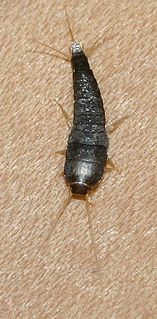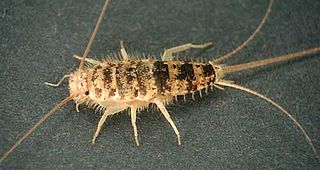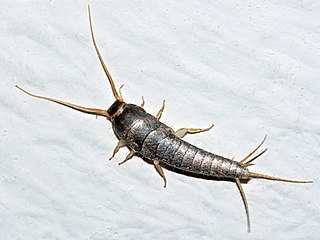Related Research Articles

The Sphingidae are a family of moths (Lepidoptera) called sphinx moths, also colloquially known as hawk moths, with many of their caterpillars known as “hornworms”; it includes about 1,450 species. It is best represented in the tropics, but species are found in every region. They are moderate to large in size and are distinguished among moths for their agile and sustained flying ability, similar enough to that of hummingbirds as to be reliably mistaken for them. Their narrow wings and streamlined abdomens are adaptations for rapid flight. The family was named by French zoologist Pierre André Latreille in 1802.

Cerci are paired appendages on the rear-most segments of many arthropods, including insects and symphylans. Many forms of cerci serve as sensory organs, but some serve as pinching weapons or as organs of copulation. In many insects, they simply may be functionless vestigial structures.

Lepismatidae is a family of primitive wingless insects with about 190 described species. This family contains the two most familiar members of the order Zygentoma: the silverfish and the firebrat. It is one of five families in the order Zygentoma.

Zygentoma are an order in the class Insecta, and consist of about 550 known species. The Zygentoma include the so-called silverfish or fishmoths, and the firebrats. A conspicuous feature of the order are the three long caudal filaments. The two lateral filaments are cerci, and the medial one is an epiproct or appendix dorsalis. In this they resemble the Archaeognatha, although the cerci of Zygentoma, unlike in the latter order, are nearly as long as the epiproct.

Ctenolepisma is a genus of primitive insects in the order Zygentoma, closely related to the silverfish and firebrat but less reliant on human habitation, some species being found both indoors and outdoors and some found exclusively outdoors. The genus is distributed nearly worldwide in warm regions. Australia lacks native Ctenolepisma, but is home to introduced species.

Ctenolepisma lineatum is a species of insect of the order Zygentoma. It is generally similar to the closely related silverfish but can be distinguished by being rather stouter and less shiny with all appendages noticeably longer. The abdomen is often marked with dark brown lines and the species is sometimes called four-lined silverfish.
A silverfish is a wingless insect in the order Zygentoma. The same name can be applied to many species in the order as a whole, which comprises the families the Lepismatidae, Nicoletiidae, Lepidotrichidae, Maindroniidae and Protrinemuridae.

The silverfish is a species of small, primitive, wingless insect in the order Zygentoma. Its common name derives from the animal's silvery light grey colour, combined with the fish-like appearance of its movements. The scientific name indicates that the silverfish's diet consists of carbohydrates such as sugar or starches. While the common name silverfish is used throughout the global literature to refer to various species of Zygentoma, the Entomological Society of America restricts use of the term solely for Lepisma saccharinum.
Thermobia aegyptiaca is a species of silverfish in the family Lepismatidae. The species was described by Hippolyte Lucas in 1840 based on specimens collected in Egypt. Thermobia aegyptiaca is distributed in Africa and the eastern Mediterranean Basin.
Ctenolepisma algharbicum is a species of silverfish in the family Lepismatidae.
Ctenolepisma dubitale is a species of silverfish in the family Lepismatidae.
Ctenolepisma electrans is a species of silverfish in the family Lepismatidae.
Ctenolepisma guanche is a species of silverfish in the family Lepismatidae.
Ctenolepisma hummelincki is a species of silverfish in the family Lepismatidae. It is found in the Caribbean Sea.
Ctenolepisma rothschildi is a species of silverfish in the family Lepismatidae. It is found in Africa, Australia, the Caribbean Sea, Europe & Northern Asia, Central America, North America, Oceania, South America, and Southern Asia.
Ctenolepisma tanzanicum is a species of silverfish in the family Lepismatidae.
Ctenolepisma targionianum is a species of silverfish in the family Lepismatidae.
Ctenolepisma targionii is a species of silverfish in the family Lepismatidae. It is found in North America.
Ctenolepisma terebrans is a species of silverfish in the family Lepismatidae.
Ctenolepisma versluysi is a species of silverfish in the family Lepismatidae.
References
- ↑ "Ctenolepisma guadianica". UCMP. Retrieved 2020-10-23.